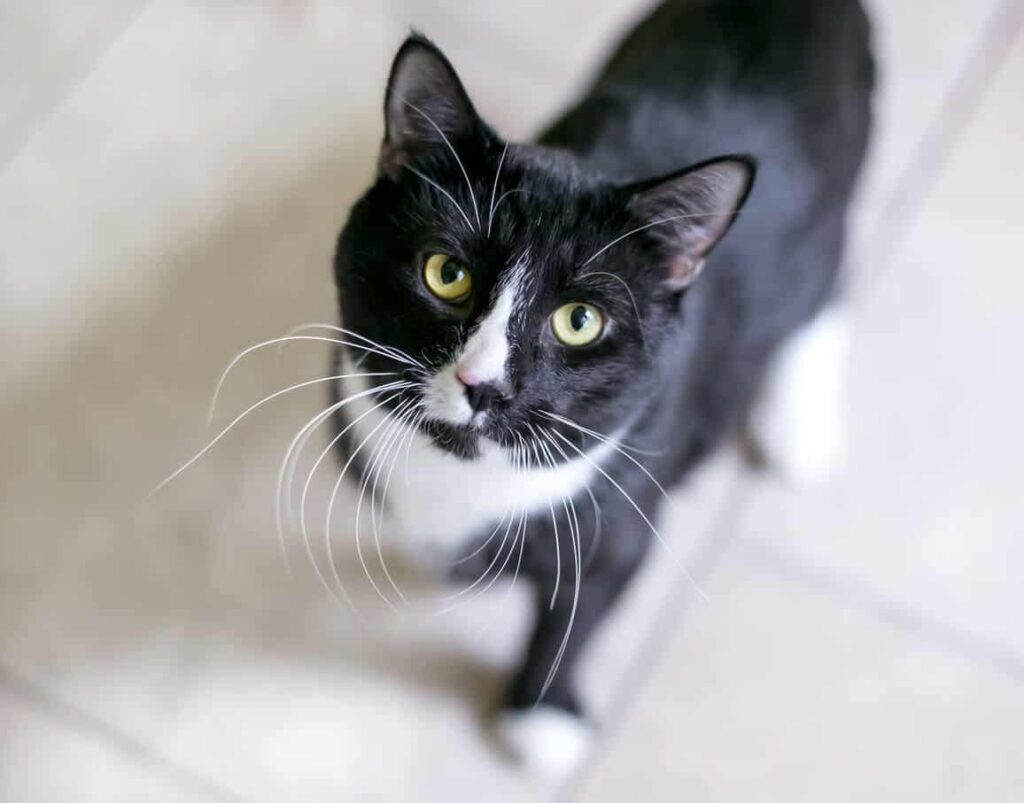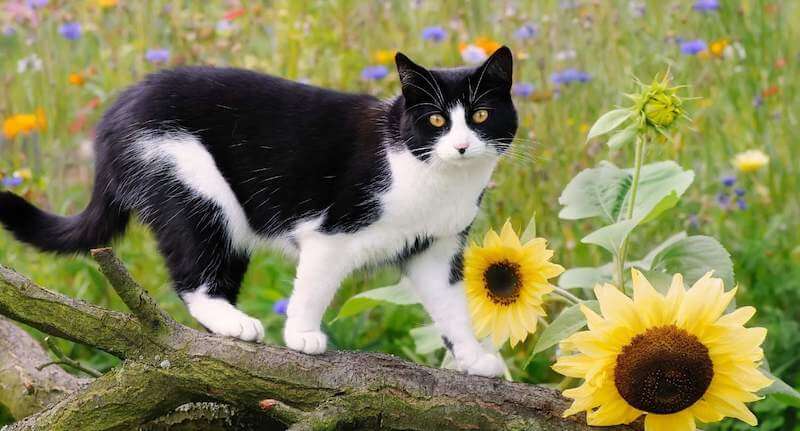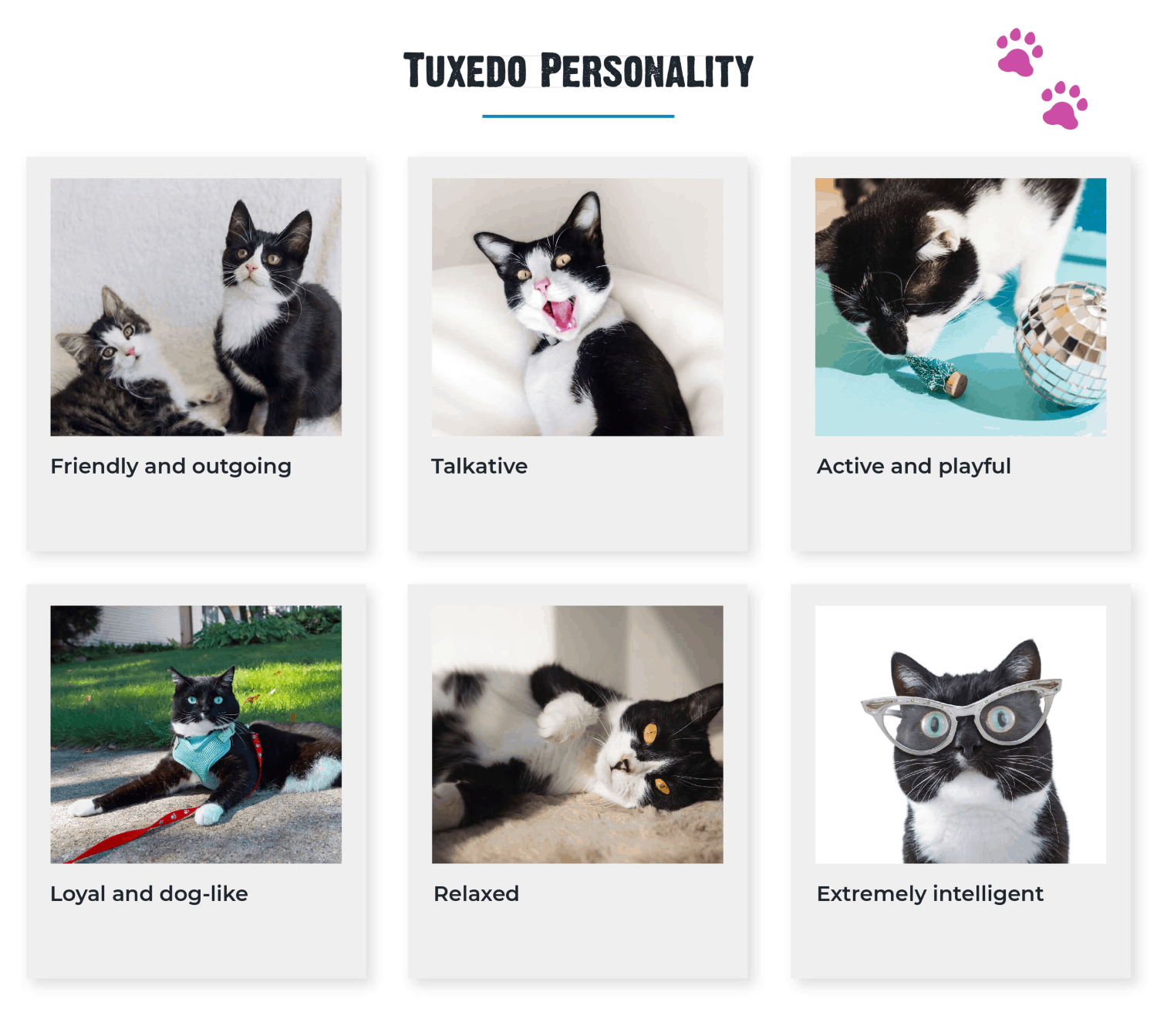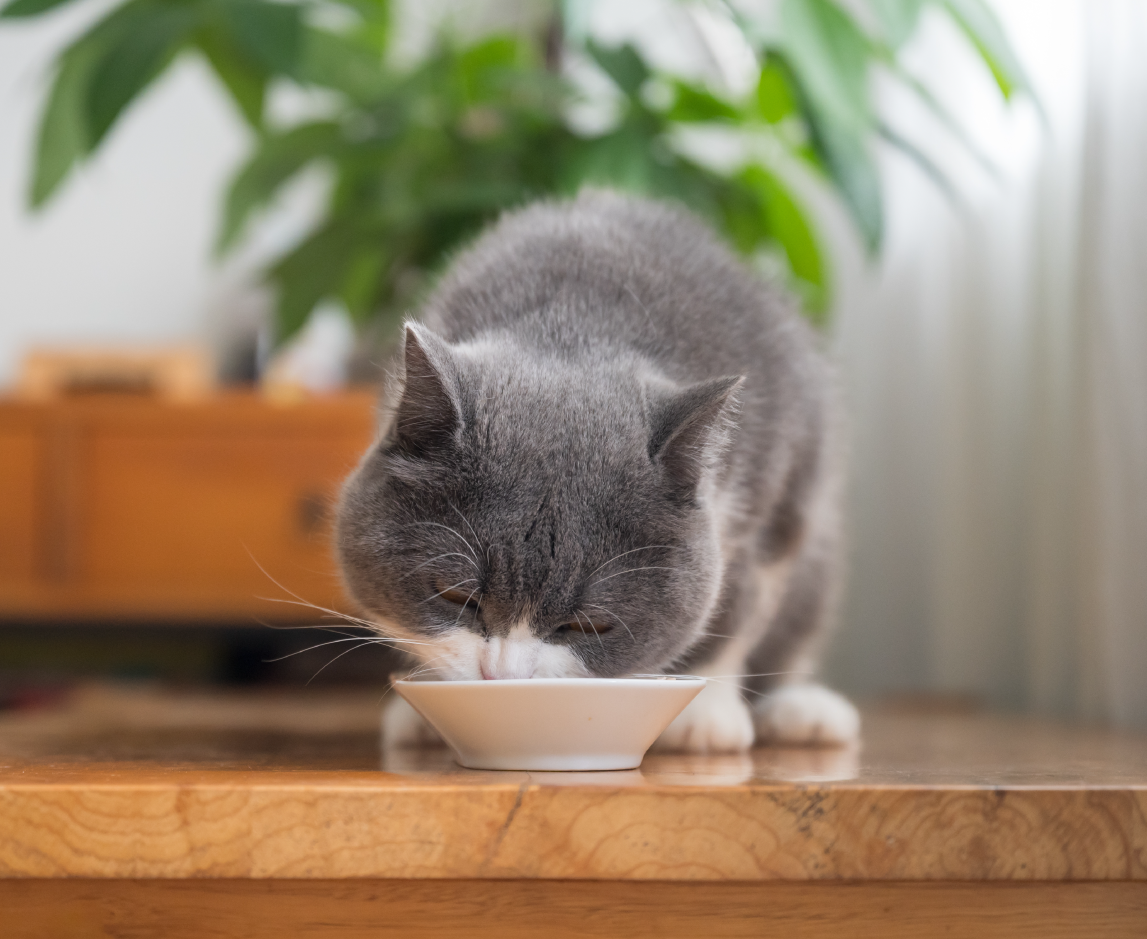10+ Facts About Tuxedo Cats [Personality, History, Health & More]
Always dressed to impress, tuxedo cats have made their mark on history. These dapper felines were not only worshipped in Ancient Egypt, they’ve also lived in the White House and served as companions for many well-known literary and science geniuses.
Tuxedo cats — also known as tuxies — may not be a breed, but there are plenty of factors that distinguish them from other types of cats. Read on for the details:
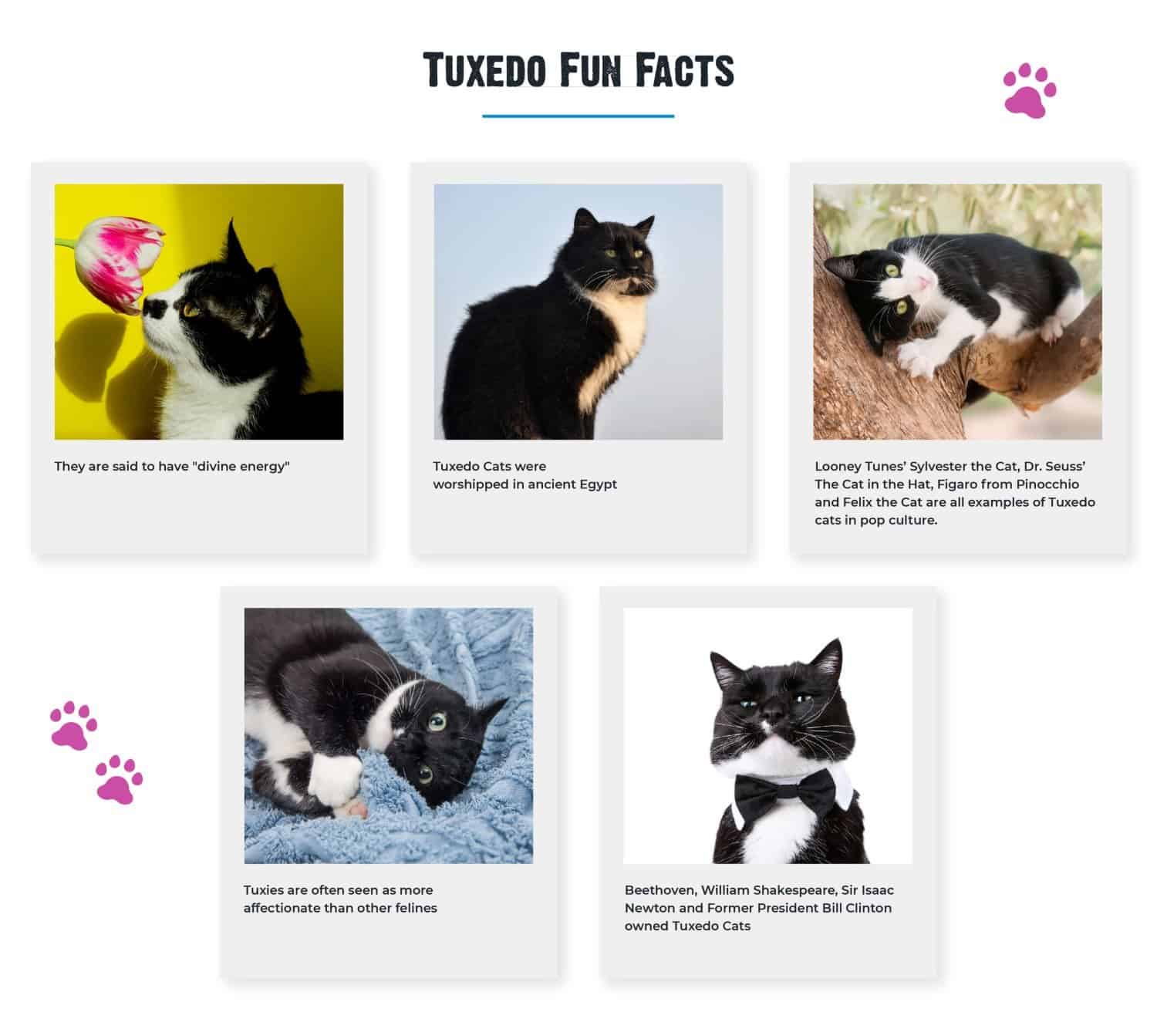
The History of Tuxedo Cats
In Ancient Egypt, felines were worshipped like gods and goddesses. Cats were mummified like royalty and represented in artwork, hieroglyphics and statues because they were believed to possess “divine energy.” While this should give all cats an ego boost, it’s even more applicable to tuxedo cats. Nearly 70% of the felines depicted in Ancient Egyptian tombs and artwork were tuxedo cats.
Thousands of years after their glory days in Ancient Egypt, tuxedo cats continued their reign, serving as companions for Beethoven, William Shakespeare and Sir Isaac Newton. Former President Bill Clinton even moved into the White House with his faithful tuxedo cat Socks by his side.
DOWNLOAD OUR 10 FACTS ABOUT TUXEDO CATS GUIDE
More recently, some of the most recognizable cats in pop culture have been tuxedos: Looney Tunes’ Sylvester the Cat, Dr. Seuss’ The Cat in the Hat, Figaro from Pinocchio and Felix the Cat.
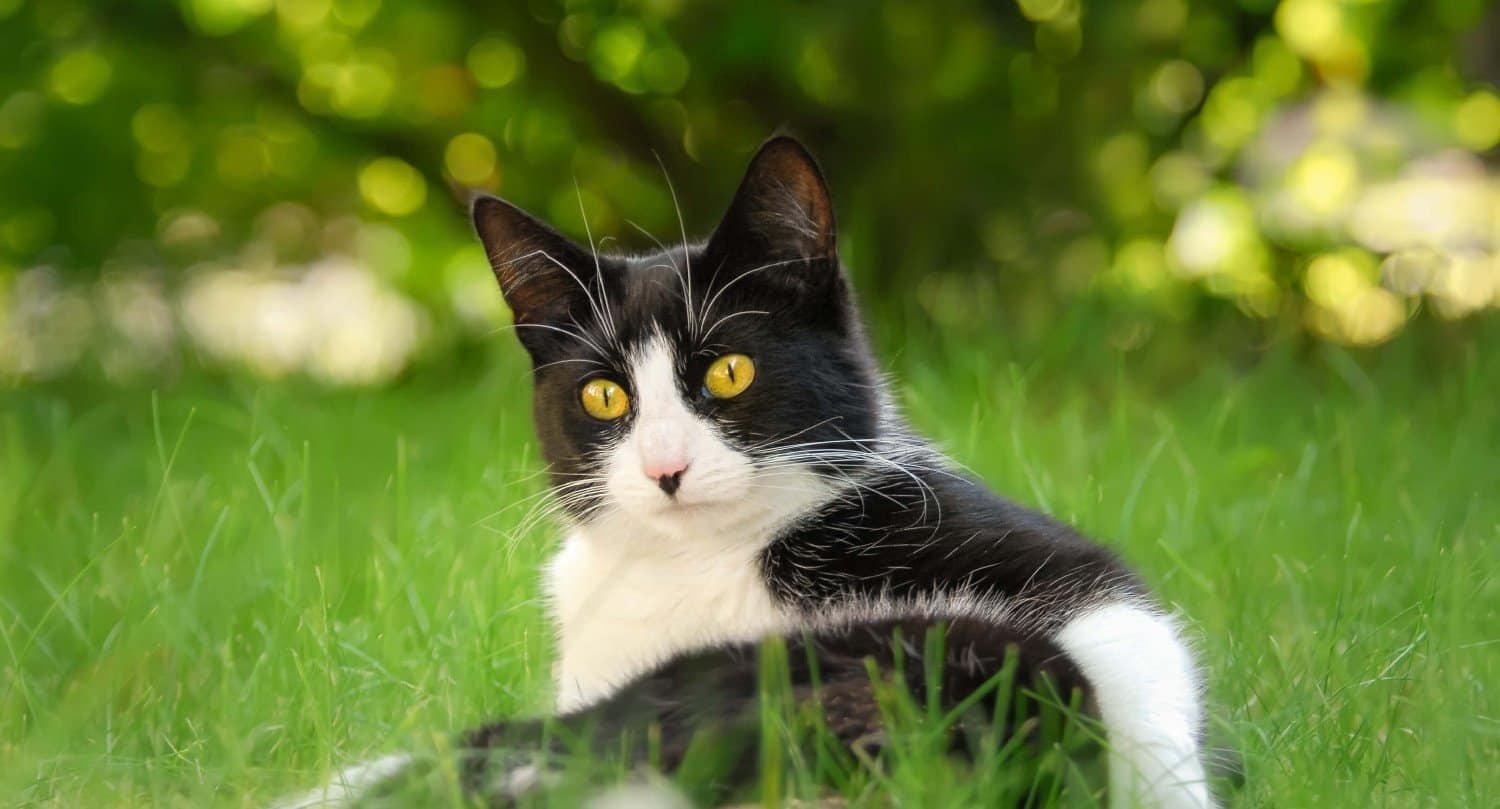
Appearance
Like calicos and tortoiseshells, tuxedo cats are not a breed. Instead, they are defined by their distinct black and white bicolored (or piebald) coats that resemble traditional formal wear. However, while calico and tortoiseshell cats are predominantly female, tuxedo cats can be either male or female.
Tuxedo cats are most often one of, or a mix of, the following breeds:
- Maine Coon
- American Shorthair
- British Shorthair
- Turkish Angora
Tuxedo Cat Coats
Tuxedo cats are synonymous with black and white coats, but some people also consider cats with orange and white or gray and white variations to be tuxedos. Typically, their bellies, chests and paws are white while the rest of their body is black, orange or gray. These patterns make it look like the cat is wearing a tuxedo, hence the name. A tuxedo cat’s face is also likely to have white markings. Since tuxedo cats can be almost any type of breed, their coats can be short or long. With so many variations, it’s no wonder why tuxedo cats are so beloved — every tuxedo cat you meet is likely to look different.
Download Our 10 Facts About Tuxedo Cats Guide
A tuxedo cat doesn’t need to have two tuxedo cat parents in order to develop their signature coat. If one parent has the tuxedo pattern, they can pass it on to their offspring. A tuxedo cat can even be born if neither of the parents have tuxedo markings — they just need to inherit black and white genes.
Scientists first attributed the bicolored markings of these cats to sluggish genes that moved too slowly to cover the cat’s entire coat. However, more recent studies suggest that the tuxedo markings are the result of a faulty KIT gene that is unable to multiply at a normal rate. The KIT gene is responsible for determining if there will be any white in the cat’s coat.
Eye Color
According to Feline Living, the gene that determines a tuxedo cat’s coat may be connected to their eye color. The majority of tuxedo cats have bright green, golden green, bluish green, gold or yellowish eyes.
Biology & Health
Since tuxedo cats come from different breeds, there are no specific health ailments that can be tied to all tuxies. There are, however, a few traits that these cats seem to share:
- Tuxedo kittens are quick to develop. While it takes most newborn kittens one to two weeks to open their eyes, tuxedo cats tend to open their eyes a full 24 hours before other types of cats.
- Tuxedo kittens also tend to reach their full height by the time they are six months old.
Download Our 10 Facts About Tuxedo Cats Guide
Weight Range
The ideal weight for every cat will depend on several factors, one of which is their breed. Tuxedos aren’t a breed, so your veterinarian will need to determine this before suggesting a proper weight range. For example, the average weight for a male American Shorthair is between 11 lbs. and 15 lbs. but a male Maine Coon can weigh between 15 lbs. and 25 lbs.
A veterinarian will also assess the cat’s age, activity level, diet and overall health to suggest a proper weight target. Providing your tuxedo cat with minimally processed, high-quality cat food is always recommended to make sure they get the proper nutrients and maintain a healthy weight.
Life Expectancy
The lifespan of a tuxedo cat is also breed dependent. In general, healthy cats that are kept indoors can live to be 17 years or older. Outdoor cats can live an average of two to five years, as noted by Fetch by WebMD.
Personality
Every tuxedo cat will have their own unique personality, especially since breeds can vary. However, tuxedo cats are known to possess a few distinct traits:
- Friendly and outgoing
- Talkative
- Active and playful
- Loyal and dog-like
- Relaxed
- Extremely intelligent
All About Cats reports that tuxedo cats are often seen as more affectionate than other felines, but studies have contradicted this thought. Since tuxedo cats have been around since Ancient Egypt, they have had plenty of time to acclimate to humans while still developing unique personalities that can vary just as much as their coat markings.
Frequently Asked Questions
Q: Are tuxedo cats hypoallergenic?
A: No cat is completely hypoallergenic. However, people with allergies may find that they are less irritated by certain breeds that produce less dander and saliva, such as Sphynx and Devon Rex. If you are considering adopting a tuxedo cat, make sure you know their breed so that you can get an idea of the potential for allergens.
Q: Do tuxedo cats get along with children and other pets?
A: This will depend on several factors. Every cat will have their own unique personality, so it’s important to consider their breed, environment and personality before determining how they may interact with other pets and humans.
Want to learn about the history, personality and biology of other cats? Check out these articles:


